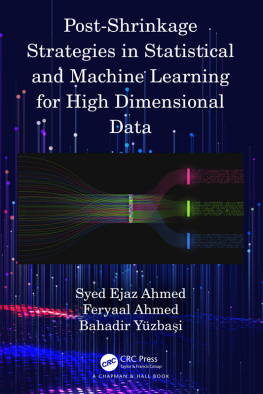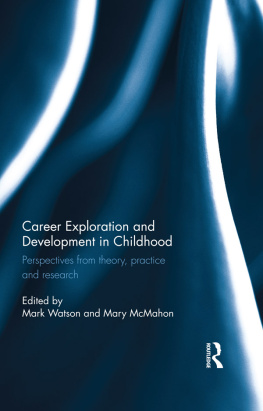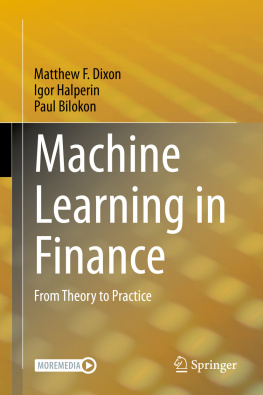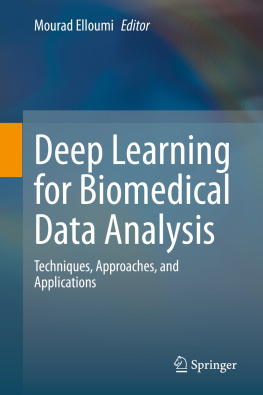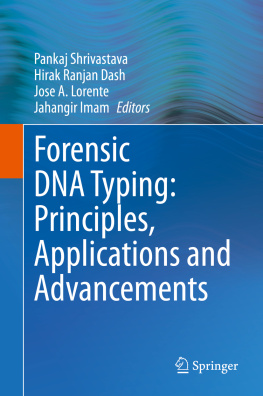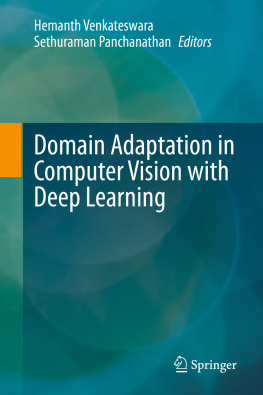Copyright
Academic Press is an imprint of Elsevier
125 London Wall, London EC2Y 5AS, United Kingdom
525 B Street, Suite 1650, San Diego, CA 92101, United States
50 Hampshire Street, 5th Floor, Cambridge, MA 02139, United States
The Boulevard, Langford Lane, Kidlington, Oxford OX5 1GB, United Kingdom
Copyright 2021 Elsevier Inc. All rights reserved.
No part of this publication may be reproduced or transmitted in any form or by any means, electronic or mechanical, including photocopying, recording, or any information storage and retrieval system, without permission in writing from the publisher. Details on how to seek permission, further information about the Publishers permissions policies and our arrangements with organizations such as the Copyright Clearance Center and the Copyright Licensing Agency, can be found at our website: www.elsevier.com/permissions.
This book and the individual contributions contained in it are protected under copyright by the Publisher (other than as may be noted herein).
Notices
Knowledge and best practice in this field are constantly changing. As new research and experience broaden our understanding, changes in research methods, professional practices, or medical treatment may become necessary.
Practitioners and researchers must always rely on their own experience and knowledge in evaluating and using any information, methods, compounds, or experiments described herein. In using such information or methods they should be mindful of their own safety and the safety of others, including parties for whom they have a professional responsibility.
To the fullest extent of the law, neither the Publisher nor the authors, contributors, or editors, assume any liability for any injury and/or damage to persons or property as a matter of products liability, negligence or otherwise, or from any use or operation of any methods, products, instructions, or ideas contained in the material herein.
Library of Congress Cataloging-in-Publication Data
A catalog record for this book is available from the Library of Congress
British Library Cataloguing-in-Publication Data
A catalogue record for this book is available from the British Library
ISBN 978-0-12-824370-1
For information on all Academic Press publications visit our website at https://www.elsevier.com/books-and-journals

Publisher: Masucci, Stacy
Acquisitions Editor: Brown, Elizabeth
Editorial Project Manager: Kuhl, Mariana L.
Production Project Manager: Raviraj, Selvaraj
Cover Designer: Rogers, Mark
Typeset by SPi Global, India
Contributors
John Albanese Department of Sociology, Anthropology and Criminology, University of Windsor, Windsor, ON, Canada
Bridget F.B. Algee-Hewitt Center for Comparative Studies in Race and Ethnicity, Stanford University, Stanford, CA, United States
Clair L. Alston-Knox Predictive Analytics Group, Melbourne, VIC, Australia
Mark D. Barry High Performance Computing and Research Services, Queensland University of Technology, Brisbane, QLD, Australia
Jesper L. Boldsen ADBOU, University of Southern Denmark, Odense, Denmark
Fred L. Bookstein
University of Washington, Seattle, WA, United States
University of Vienna, Vienna, Austria
Guillermo Bravo Morante
University of Granada, Granada, Spain
Konrad Lorenz Institute for Evolution and Cognition Research, Klosterneuburg, Austria
Hugo F.V. Cardoso Department of Archaeology, Simon Fraser University, Burnaby, BC, Canada
Louise K. Corron University of Nevada, Reno, NV, United States
Eugnia Cunha
University of Coimbra, Centre for Functional Ecology, Laboratory of Forensic Anthropology, Department of Life Sciences, Coimbra
National Institute of Legal Medicine and Forensic Sciences, Lisbon, Portugal
Susan R. Frankenberg Department of Anthropology, University of Illinois at Urbana-Champaign, Urbana, IL, United States
Sara M. Getz Department of Criminal Justice, University of Wisconsin, Platteville, WI, United States
Laura S. Gregory Faculty of Health, Skeletal Biology and Forensic Anthropology Research Laboratory, School of Biomedical Sciences, Queensland University of Technology, Brisbane, QLD, Australia
Jieun Kim Anatomy, Lincoln Memorial University, DeBusk College of Osteopathic Medicine, Knoxville, TN, United States
Lyle W. Konigsberg Department of Anthropology, University of Illinois at Urbana-Champaign, Urbana, IL, United States
Nicolene Lottering
Faculty of Health, Skeletal Biology and Forensic Anthropology Research Laboratory, School of Biomedical Sciences, Queensland University of Technology, Brisbane
Faculty of Health Sciences and Medicine, Bond University, Robina, QLD, Australia
Donna M. MacGregor Faculty of Health, Skeletal Biology and Forensic Anthropology Research Laboratory, School of Biomedical Sciences, Queensland University of Technology, Brisbane, QLD, Australia
George R. Milner Department of Anthropology, The Pennsylvania State University, University Park, PA, United States
Stephen D. Ousley Department of Anthropology, University of Tennessee, Knoxville, TN, United States
Michael H. Price Santa Fe Institute, Santa Fe, NM, United States
Luis Ros Departamento de Biodiversidad, Ecologa y Evolucin, Universidad Complutense de Madrid, Madrid, Spain
Marta San-Milln
EUSES University School of Health and Sports, University of Girona, Girona, Spain
Group of Research on Clinical Anatomy, Embryology and Neuroscience (NEOMA), Department of Medical Science, University of Girona, Girona, Spain
Laure Spake Centre for Research on Evolution, Belief and Behaviour, University of Otago, Dunedin, New Zealand
Kyra E. Stull
University of Nevada, Reno, NV, United States
University of Pretoria, Pretoria, South Africa
Peter Tarp ADBOU, University of Southern Denmark, Odense, Denmark
Flvia Teixeira University of Coimbra, Centre for Functional Ecology, Laboratory of Forensic Anthropology, Department of Life Sciences, Coimbra, Portugal
Svenja Weise ADBOU, University of Southern Denmark, Odense, Denmark
Looking back and forward: An introductionDefining, refining, and [re]modeling age estimation: A trajectory for forensic anthropology
Jieun Kim; Bridget F.B. Algee-Hewitt
Aging is a topic of considerable importance in biological anthropology. The steady number of publications and their emphasis on method development, testing, and validation provides clear evidence of sustained interest, while the history of debate over the validity of this theoretical work and their practical outcomes is testament to the depth of our collective investment. There is no denying how the reliable estimation of age-at-death from the human skeleton is of fundamental importance for the value that it brings to the field, and subfields, of biological anthropology, and to the areas of specialty and subject matter with which it interacts.
The study of age contributes to our understanding of morphological variation and the senescent process in modern population biology. As such, skeletal development and degeneration has implications that reach into the anatomical and medical fields as we, as skeletal biologists, can grapple with the effects of genetics, environment, and individual lifestyle factors on bone density, rates of fracture healing, and atypical skeletal expression. Estimating age is important among the personal identity parameters that are used in medico-legal case identification in forensic anthropology, as we seek to provide law enforcement, medical examiner, and nongovernmental agencies with the information that can help to link the unknown individual with the named person. In these circumstances, the anthropologist, working in the service of humanitarian aid and social justice, estimates skeletal age to assist in missing person, asylum seeker, and undocumented death cases. Finally, age-at-death is fundamental to the paleodemographic reconstruction of mortality profiles for skeletal assemblages in bioarcheology, allowing us to bring a better understanding of the life and death of past peoples.


